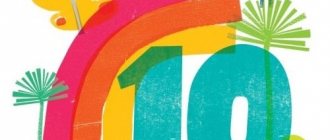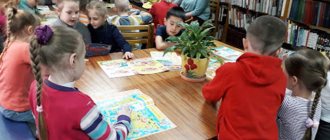Your own system operator
TRIZ technology method “System Operator” as a means of developing the creative initiative of a preschooler
Humanization, socialization, individualization are the basic principles enshrined in regulatory documents on preschool education. One of the primary tasks of education and training, according to the Federal State Educational Standard for Education, is raising a generation of children with high creative potential. But the problem is not the search for gifted, brilliant children, but the purposeful formation of creative abilities, the development of a non-standard vision of the world, new thinking in all children.
It is the TRIZ-RTV technology that most fully allows the teacher to implement these most important principles in a form that is accessible and interesting for children: teaching children how to independently obtain information is possible through search activities, and through organized collective reasoning, and through games and trainings. Therefore, TRIZ can be called a school of creative personality. My work experience has shown that the use of TRIZ elements in the development of preschool children radically changes the teacher’s work style, liberates children, teaches them to think and look for solutions to problems.
I have tried several methods and techniques known in TRIZ technology, I often use them, but I especially like working using the “System Operator” method. I set myself the task of teaching children to think in large categories with the help of a “system operator”, using tables and diagrams, to develop an understanding of the structure and stages of development of a system, and to develop a figurative representation of creative potentials.
“System operator” is one of the first exercises in the development of systemic logical thinking, which allows you to see an object simultaneously in structural, functional, temporal aspects, as well as its anti-system.
The system operator allows us to consider what the object of interest to us consists of and is a part of; introduces the functional features of individual parts, the system itself and the subsystem as a whole when moving vertically from bottom to top. It allows us to analyze the object of interest to us in time at the level of the system, supersystem and subsystem.
Regular use of the “system operator” technique develops in the child the skills of system analysis and systemic multi-screen thinking. The children in my group have known “The Magic Screen” for almost three years. At the first stage of training for children of primary preschool age, I used horizontal and vertical “three-screens”. In the middle group, five screens were administered. For children of senior preschool age, the most common option is already available - nine screens.
In early preschool age
I began my work by developing the skills to analyze and generalize; develop imagination, introduce and train, use the “system elevator” model. For analysis, I involved objects of inanimate nature from the immediate environment of children (pieces of furniture, vehicles, clothing, toys) and objects of living nature (domestic and wild animals, birds). First, we looked at the subsystem characteristics, immediately after the name of the system (object), and then we determined which supersystem it belongs to. I formed children’s ideas about changes in an object over time, using technological chains in my work. Depending on the individual characteristics of the children, the length of the chain was gradually increased. At a younger age, two or three options were enough. For a visual demonstration to children, I often used a train with carriages.
In middle preschool age
I continued to teach children to use component and genetic approaches to consolidate ideas and gain more detailed knowledge about the supersystems and subsystems of objects of living and inanimate nature. I introduced the children to a model of analyzing objects using five screens (with a magic TV where we can see what the object of interest to us consists of and is a part of). Children learned the functional features of individual parts, the system itself and the subsystem as a whole when moving vertically from bottom to top. We also analyzed the object of interest to us in time at the level of system, supersystem and subsystem.
Children of senior preschool age
I introduced the name of the technology “system operator”. I use the five and six screen object analysis model to create fairy tales and stories. I invite children to consolidate their results schematically or in a drawing (especially the future of the object). And we start working with the full version of the “system operator” - nine screens. When examining an object, children determine what parts it consists of and its type (transport, toy, clothing). Children find out the history of the origin of a given object, what object performed its functions before its appearance, this object is analyzed in the same way. Next, children are given the opportunity to imagine what the object will become in the future: its functions, appearance, what it will be called. In older preschool age, we learn with children to follow the correct sequence, as it gives a more multifaceted view of the system in question. When using the “system operator” when working with children, I do not always look at all screens in one lesson or in one game. Only those screens that are needed at the moment to achieve any goal are considered.
In the course of working using the “system operator” method, I was convinced that children’s imagination and fantasy, thinking and creative abilities are developing; knowledge obtained in a form that is fun and interesting for children ensures their strong assimilation and systematization. TRIZ methods allow you to work on the principles of cooperation pedagogy, put children and the teacher in the position of partners, stimulate the creation of a situation of success for children, thereby supporting their faith in their strengths and capabilities, and interest in understanding the world around them.
Working with the “system operator” develops in a child the ability to analyze and describe the system of connections of any object of the material world: its purpose, the dynamics of development in a certain period of time, signs and structure, that is, the child receives not chaotic isolated knowledge, but a holistic picture of the world.
Elena Saifullina, teacher at MBDOU Central Children's Resource Center for Children's Rehabilitation School No. 389, Chelyabinsk
TRIZ plus
The goal of TRIZ is not just to develop a child’s imagination, but to teach him to think systematically, with an understanding of the processes taking place. To give adults - teachers, parents - a tool for specific practical education in children of the qualities of a creative personality, capable of understanding the unity and contradiction of the world around them.
Using the TRIZ “System Operator” technique allows you to view an object in time and space. Regular use of the SO (System Operator) technique develops in the child “system analysis skills, systems thinking, or multi-screen thinking” (G.S. Altshuller)
These are very important skills and thinking style: thinking about the future means not making mistakes in the present, and thinking about the past means not making mistakes in the future.
In order to think about the past, you need relevant information, you need knowledge. Giving them is the task of an adult, and giving them without embellishing the past or simplifying it.
The present is recognized by the child on the basis of analysis and generalization, therefore the help of an adult in the form of “giving out” ready-made information about the present is not desirable.
Thinking about the future is the most difficult element of thinking. Basically, the child’s imagination works here. Helping him in this case means thinking for him, that is, depriving him of the joy of creativity. At the same time, it is necessary to tactfully and unobtrusively help the child see the relationship between the future and the present.
In kindergarten, this technique was called the “Magic Screen”
(for some authors - “Magic TV”). The most common option is nine-screen, but it is more accessible to children of older preschool age. For kids, “cut-down” options are used: Vertical three-screen, Horizontal three-screen, Six-screen. Working with the Anti-system and Non-system in preschool age, as a rule, is not used.
What is the “Magic Screen”
?
Does it look “scary”? But this is only at first glance. Let's understand the terms and look at them with examples. (It should be clarified that children do not necessarily need to be “loaded” with these terms, but adults guiding the process of analyzing a child do.)
System
– this is our object under consideration.
You need to understand that any object, living creature, natural or social phenomenon is a system: it necessarily consists of parts, it must itself be a part of something, it must function in some way (has its own function
). Moreover, each system has a past and a future.
Subsystem
- this is part of the system, or the elements that make it up (for example,
system
: Car,
subsystem
: wheels, body, steering wheel, headlights, seats, bumper, etc.;
system
: Rain,
subsystem:
cloud, water drops;
system
: Tree,
subsystem
: root, trunk, leaves). Each of the subsystems has its own function, without which the system cannot exist (If the root dries out, the tree will die; if it loses its branches, it will not be able to bloom and bear fruit, etc.) The subsystem also consists of parts or elements (for example, a Leaf consists from cuttings, leaf blades, veins, etc.), but in preschool age you don’t have to go to this level.
Supersystem
is a larger system of which the system in question is a part.
The supersystem can be generic
(a tree can belong to the generic classification “plant”) or
by location
(a tree can be classified as a forest, garden, park, etc.)
Every screen
reflects a certain part of the World at a certain time of its existence. The central screen is the system currently selected for review. Three screens on the horizontal middle level reflect changes in the system during the transition from the Past to the Present and the Future.
And the three middle screens at the vertical level are a subsystem and a supersystem.
In the next article we will look at the Magic Screen in more detail.
From personal experience: working with the “Magic Screen” only at first glance seems complicated, incomprehensible and difficult to implement. In fact, no special training or complex materials are required at all. The main thing is that the systemic, screen vision is in the adult’s head. And you can even use it verbally: for example, you came to the village with your child in the summer, and the child looked at the chicken with interest. Join us! “Oh, what a little yellow lump! Do you know who is it? Chick! What does he have? (paws, beak, eyes, etc.) What was he before, where did he come from? Yes, can you imagine, such a chicken hatched from an egg! And when he grows up, who will he be? (chicken or rooster). Let's see where he lives? What is the name of his house? (chicken coop). But how can you call a chicken, a hen, a rooster in one word, who are they? (birds or poultry). As you can see, this is not only very simple, but also useful: in just one observation, the child received a complete picture of the chicken. And if necessary, you can use any piece of paper and draw schematically on it - your artistic talents are not important here, the main thing is to record the process of observation, reflection, and systemic analysis.
I remembered one incident from personal practice - on a walk with 3-4 year old kids, we looked at pigeons that were walking on the ground not far away. When all the visible parts of the pigeon were named, I asked: - Where are the hands??? The children looked closely and said that there were no hands... I “spurred” their thinking: - But what about without hands... We have hands, but why don’t pigeons? Maybe they are very small and we don’t see them? The kids began to think, continuing to look at the pigeons: maybe there are hands under the wings, or do they have paws instead of hands?... And one girl exclaimed joyfully, incredibly pleased with her intelligence: “And they have WINGS INSTEAD OF HANDS!”
Did you like the article? Share with your friends
Progress of the game:
“Magic traffic light”
(held from the beginning of the middle group)
Rules of the game: At the “Magic traffic light”
red color means
a subsystem of an object , yellow means a system , green means a supersystem . Thus, any object is considered. The item in question can hang (lie)
in front of the child, or can be removed after the display.
The teacher shows a picture of an animal.
Teacher : If I raise a red circle, you will tell me the parts of the animal. If I hold up the green circle, you can tell me what the animal is part of. And if I raise a yellow circle, then you tell me what it is for or what benefits it brings. This game can be used when looking at a picture on any topic, including the topic “Animals”
.
Teacher : Hare (raises a green circle)
.
Children: The hare belongs to the natural world, to a living system , to wild animals. He lives in the forest.
Teacher : Raises a red circle.
Children: A hare has a head, ears, body, tail, paws, nose, fur.
Teacher : Why does the hare change its coat in winter?
Children: To hide from enemies: foxes, wolves.
Teacher : raises a yellow circle.
Children: A bunny is a kind, harmless animal, it does not offend anyone. It is needed so that animals can live in the forest and it will be beautiful.
This game can be used when viewing a painting.
If I raise a red circle, you will name the objects that you see in the picture. If I show you a yellow circle, you can tell me what this picture can be called. And if I raise the green circle, determine what the plot of the picture is part of (the natural world, transport, pets)
.
The object is a house.
Goal: Formation of the ability to think systematically , with an understanding of ongoing processes, development of imagination.
Material: pictures depicting objects of living and non-living nature, objects of the man-made world, etc.







